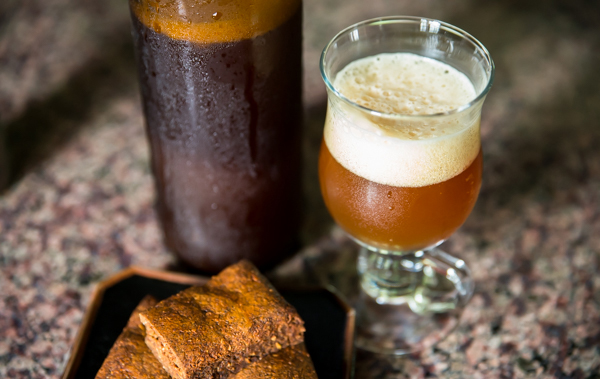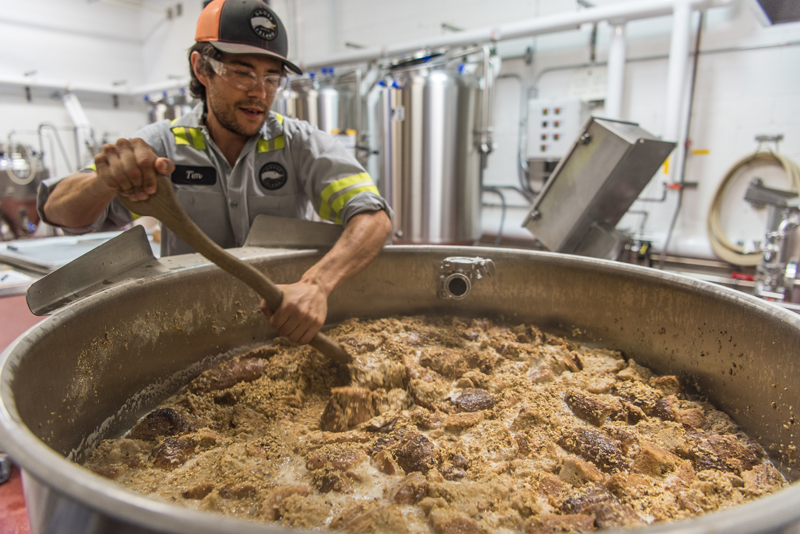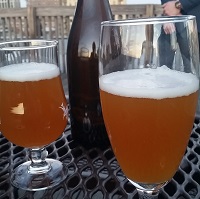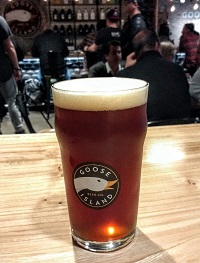Liquid Bread: Brewers Experiment with Kvass

Kate Alimpiyeva’s homebrewed kvass. (Photo by Kate Alimpiyeva)
Kate Alimpiyeva, who moved to the U.S. from Ukraine in 1999, had a cultural taste for tartness that predated the cusp of the sour beer craze here in the States. Even as the trend dawned, she longed for something that never quite made the jump to the U.S.—a traditional, fermented Eastern European beverage called kvass (pronounced “quass”). That desire in mind, and with a food blog and culinary degree under her belt, she approached her favorite local brewery, Jester King Brewery in Austin, Texas, with a homebrewed sample of the drink and some recipes.
“When I thought if anybody in Texas who could make kvass popular … it would have to be someone with a reputable name who people will trust,” she said. “Because [Jester King’s] were our first craft beers, it was a dear experience to our family.”
Egged on by Alimpiyeva, Jester King brewed the brewery’s first, 35-barrel batch of kvass in July. It joined a small handful of domestic breweries that include Scratch Brewing Co. (Ava, Illinois), Fonta Flora Brewery (Morganton, N.C.) and Beaver Brewing Co. (Beaver Falls, Pennsylvania), all of which were among the first stateside to foray into this untapped Eastern European drink.
Though only a modicum of breweries are working with kvass, the beverage bears a series of characteristics that prime it for the American beer scene: It’s sessionable, lactic and comes with heritage.
“It’ll help this drink to become popular, and it deserves it. It has all the qualities to become popular,” Alimpiyeva said.
Goose Island Beer Co., no stranger to trend setting, will be releasing its first limited batch of kvass this December at its Fulton Street taproom in Chicago.
Textual references date kvass back to the Middle Ages. Peasants originally consumed the drink as a way to stretch stale bread and purify water—as Alexander Pushkin later wrote in his verse novel, Eugene Onegin, “Kvass needful was to them as air”—but it was eventually adapted by all as a refreshing tipple.
Traditionally made by open fermenting a slurry of water and hard breads made from dark grains—standard kvass is not quite a beer, but a fermented beverage—kvass is a stalwart component of Russian and Eastern European food culture. It appears in Leo Tolstoy’s War and Peace, where French soldiers refer to it as “pig’s lemonade,” and also in Fyodor Dostoyevsky’s Brothers Karamazov, whose hero consumes a particularly venerated iteration while fasting at a monastery. Former Soviet premier Nikita Khrushchev even pushed kvass as a patriotic alternative to cola.
Alimpiyeva said that the “standard” kvass recipe that characterizes most Eastern Europeans’ idea of proper kvass was a state-regulated recipe put in place by GOST during the Soviet Union. She explained that while malted grains and adjuncts such as beets and honey can be used in making the beverage—“When you think about red wine and imagine all kinds of red wine made all over the world, it’s the same huge world for kvass,” she said—the state ordered kvass to be made from a hard, inedible bread made from malted rye and wheat, a loaf inventively named “kvass bread.”
Alimpiyeva holds that recipe up as a paragon, but conceded that the basic characteristics truly requisite to making kvass are mixed Lactobacillus and yeast fermentation, natural carbonation and, frequently, the inclusion of milled, dark grains such as rye (she particularly lauds a red rye malt variety that she said is next to impossible to find outside of Eastern Europe, though it can be approximated by crystal or caramel rye malt).
Jester King and other breweries’ experimental forays into the beverage are turning kvass in a distinctly more beer-like direction, upping both grain-to-bread ante and alcohol levels. While this would likely cause Kruschev to raise an eyebrow, so would most of the kvass commercially made today. According to Alimpiyeva, those kvasses are a far cry from what was once consumed by Eastern European peasants. Ironically, they’re like cola—manufactured, sweet and extract-laden soft drinks.
Dan Woodske, owner of Beaver Brewing, is trying to turn back time on that industrialization.
“Breweries are always making weird-ass beer and sour stuff, but the reason you don’t see [kvass] is it’s maybe on the high side about 1 or 1.5% ABV, and the school of hops, that doesn’t really go into kvass either,” said Woodske. Traditional kvass, he also said, has low shelf life because of its low hop and alcohol contents.
Woodske brews his kvass using a process as ancestral as the drink. He takes toasted bread, pours warm water over it, and adds in lemon and raisins—two adjuncts that he said he encountered frequently in kvass literature. Then without taking a temperature reading—“No one was taking a temperature reading when it was 1500 AD and they were making kvass,” he said—he lets the beverage steep for a few hours and then open ferments it.
“I literally add a couple of handfuls of grain and two hops to it just so it’s classified as beer, but they’re definitely not part of the base or flavor profile at all,” said Woodske.
“It’s not really beer,” he continued. “I have people that drive hours to mark it off their checklist, just cause you can’t try it anywhere else.”
Woodske sometimes loosens his bounds and adds other adjuncts such as beet, lavender and mint to his kvass. Fonta Flora has likewise added distinct ingredients that include beets, maple syrup, spearmint and caraway seeds to its series of kvasses. However, Fonta Flora’s versions of the beverage, made in collaboration with fermentation gurus and bakers such as Sandor Katz and David Bauer of Farm & Sparrow Bakery in Asheville, North Carolina, are more in line with Jester King’s kvasses—both use a house culture-inoculated, bread-plus-grain method (in this case, malted barley and rye) to produce modernized kvasses that clock in between 2-4% ABV.
“We’re cheating and kind of making an imperial kvass,” said Todd Boera, co-owner and brewer at Fonta Flora.
The types of bread used for kvass are key to its flavor, and have brewed crucial partnerships between brewers and bakers. Jester King owner Jeffrey Stuffings said that he wants to work with his supplier, Austin-based cottage bakery Miche Bread, to see how different loaves will change the outcome of his recipe. And while Fonta Flora’s first kvass was made with a wheat and rye loaf, and Bauer made a sourdough rye loaf for the second batch, the latest kvass Boera made is a salty take on the lactic style, using pretzels from Underground Baking Co. in Hendersonville, North Carolina.

(Photo courtesy Goose Island Beer Co.)
Goose Island brewer Tim Faith made his first batch of kvass in college after collecting leftover bread from his brother’s job at a bakeshop in Iowa City, Iowa. Later, he made a 10-barrel batch during his stint at New Holland Brewing Co., using around 350 various leftover loaves he collected from beer festivals. The kvass he created at Goose Island was made in partnership with Chicago bakery, Baker Miller, using rye loaves spiced with rosemary and orange peel. Outside of tradition, Faith chose to ferment Goose Island’s kvass using the brewery’s house ale strain, resulting in a distinctive, English bitter-like version of the beverage.
At Goose Island’s brewery on Fulton Street, Faith mused on the variety of flavors and textures this newly emergent—or rather, re-emergent—style can produce.
“Perhaps we’re not really creating a category, but we’re encouraging a category to have more life,” said Faith.
Boera, of Fonta Flora, struck a similar note. “I wouldn’t say that it’ll be this resurgence of kvass, but I think it’ll be a dozen or so cool breweries that are experimenting with it,” he said. “It’s not really a style of beer, but a fusion we’re trying to make happen.”
Bo McMillan is an editorial assistant at All About Beer Magazine. He currently lives in Chicago.
Tasting Notes
 Jester King Kvass
Jester King Kvass
Jester King Brewery
Austin, Texas
3.4% | Farmhouse Ale w/ Miche Bread
This kvass pours with verve, rearing into a fluffy head from a honey and copper-colored body. The nose is lightly funky and sweet, and the taste is dry but unaggressive, though full-bodied. Notes of stone fruit and lactic acid dance with a hint of blue cheese and a levain loaf background, which becomes more present in the aftertaste. Supremely satisfying as a palate cleanser, a session beverage and an isolated treat. In no way does the beer’s low alcohol content have a deleterious effect on the flavor.
 Goose Island Kvass
Goose Island Kvass
Goose Island Beer Co.
Chicago
4% | Kvass
Imagine the most caramelly, spicy, classic English bitter and give it the creamy chewiness of an unfiltered dunkel. It makes perfect sense, since this kvass was actually fermented using Goose Island’s house ale strain instead of the more standard “wild” kvass fermentation. That texture is visible: this beer pours a hazy, deep amber-brown and with excellent head retention. The taste leads with caramelly, spicy malt, and the rye from the Baker Miller bread peeks out in wonderfully nuanced balance. On the back end you get a touch of saltiness, a breeze of rosemary, and a tickle of orange peel—and not in a cocktail-like fashion, but more in the savory way, like finishing the last bite of an artisan loaf. Little to no sour flavor, except maybe a tinge on the nose. This would be one of my go-to session beers if Goose Island produced it year-round.

We have some choice of kvass in Latvia, it is also included in local beer competitions (category fermented beverages), and a law provides strict distinction between kvass, which shall be fermented, and kvass-like beverages made from concentrate and carbonated water. The strongest kvass is 1% abv only (usually 0,5) and in terms of restrictions doesn’t fall under those for the alcohol beverages. Kvass is rateable in the RateBeer.com, however they need a separate kvass category, now it’s going under low alcohol.
I live in Iowa. Where can I buy some kvass? Cheers.
I live in SW Iowa. Although I haven’t found any for sale, I have made both beet and rye kvass myself with little effort. Both are delicious.